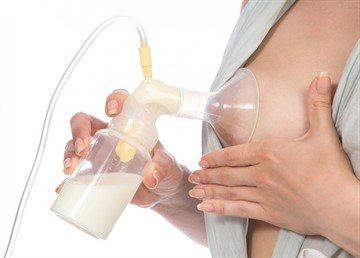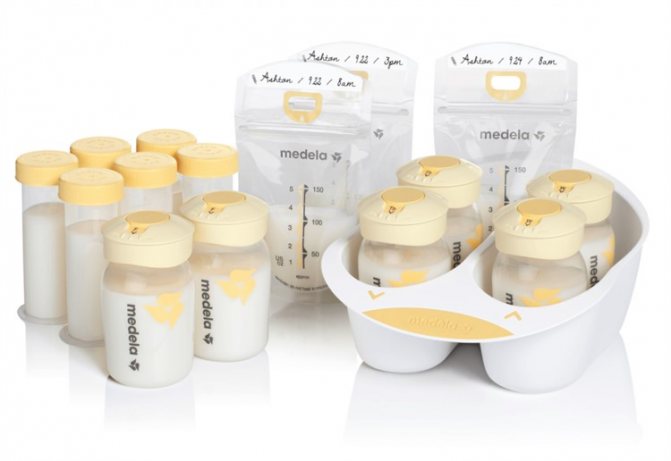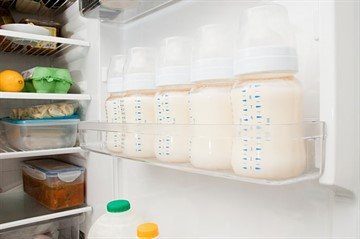Every young mother knows how important breast milk is for a child. The lactation period does not always go without problems. It happens that a woman’s milk production decreases or stops.
Sometimes situations arise when you have to stop lactation. It is useful to understand how to preserve milk from a nursing mother.
What problems can a woman encounter when breastfeeding?
Every woman, even during the period of bearing a baby, thinks about how and what she will feed him. Pediatricians strongly recommend giving your baby breast milk. This type of nutrition is the best for a baby.
Mother's milk contains sufficient quantities of all the substances that the baby needs for normal development. When breastfeeding, a woman should lead a healthy lifestyle and also be with her baby at all times to feed him on demand. Unfortunately, mothers do not always fulfill these conditions.
Common problems during lactation:
- lactostasis . This is a pathological condition in which the ducts of the mammary glands are blocked and an inflammatory process develops. With lactostasis, a woman notices the appearance of a lump in the breast, swelling. The temperature may rise. The volume of milk released from the sore breast decreases. Lactostasis often occurs due to non-compliance with the feeding regimen and technique;
- lactation crisis . This is a condition in which breast milk production is temporarily reduced. It can occur against the background of overwork, violation of the mother’s diet and regimen, and growth spurts in the child. Lactation crises often occur at 3-7 weeks, 3, 7 and 11 months of a baby’s life. Their duration ranges from 2 to 7 days;
- insufficient milk production . May be due to hormonal imbalance in a woman, improper organization of feeding;
- excess milk production . Usually observed at the beginning of the lactation period. It can also occur with frequent pumping or uncontrolled use of lactogenic drugs. The danger of this condition is that it increases the risk of developing blockage of the mammary gland ducts, mastitis, and depletes the woman;
- baby's refusal to breastfeed . This often happens when a woman breaks her diet. Eating spicy foods and spices leads to changes in the taste and smell of milk. Also, breast refusal is possible if the baby’s health is impaired or if the baby is too lazy to suckle after he has been given milk (formula) from a bottle with a nipple at least once;
- the need to temporarily stop breastfeeding . The reason may be that the woman is undergoing drug treatment (for example, taking antibiotics, antihypertensive drugs).
According to the recommendation of the Ministry of Health of the Russian Federation and WHO, children up to six months should be exclusively breastfed and, if possible, it is better not to deprive the child of this type of nutrition until two years or more.
What mothers worry about when breastfeeding
Most often, mothers are worried about an insufficient amount of milk, despite objective signs that there is enough milk:
- baby's appearance;
- the presence of numerous “folds”;
- sufficient weight gain;
- frequent urination (10-12 times a day)
Most mothers solve this problem by supplementing with expressed breast milk or formula. When breastfeeding is combined with feeding from a plastic bottle, the sucking mechanism changes. The baby begins to latch on incorrectly, does not receive enough milk and may refuse further attempts, demanding a bottle.
If in this situation you want to maintain breastfeeding for as long as possible, you need to take a responsible approach to choosing a bottle. The anatomical soft bottle Natural Nurser from Adiri is the first bottle that follows the shape of a woman's breast. Maximum conformity to the anatomy of the mother's breast helps the baby maintain proper sucking skills and train the tongue, lips and jaws. When using a soft bottle, the same type of sucking as when breastfeeding is maintained.
How to maintain lactation?
It is important to know how to preserve milk for a nursing mother. Deterioration of lactation is considered the most common problem. Experts note that the best method of maintaining and enhancing milk production is to frequently put the baby to the breast.

The best positions for breastfeeding
If the child refuses this type of feeding or there is a temporary separation from the baby, then the woman is recommended to pump regularly (every 3 hours). The resulting milk can be fed to the baby from a bottle. Many young mothers are interested in how to maintain lactation when introducing complementary foods.
Pediatricians recommend that after the baby has been fed puree or porridge, offer him the breast as well. It is also worth pumping. It is important to remember that milk production can be disrupted due to a woman following a strict diet to lose weight or insufficient fluid intake. Illness and overwork also have a negative effect on lactation.
The mother is required to adhere to the following preventive measures:
- strengthen the immune system to increase the body's resistance to infections and viruses;
- rest, get enough sleep;
- do not be nervous and do not be influenced by stressful situations;
- eat healthy and regularly. Include permitted products in the menu;
- follow the technique and mode of attaching the baby to the breast;
- drink at least 2-2.5 liters of water per day;
- treat all diseases in a timely manner;
- minimize physical activity;
- to refuse from bad habits.
If there is insufficient milk production, a woman is advised to consult a doctor. The doctor can select medications to normalize lactation.
4mama
If the mother has a mild infectious disease
There is no need to interrupt feeding.
The following chain works: before the symptoms of the disease appear in the mother, antibodies are produced in her blood, which the baby also receives with milk. This happens almost immediately after the child gets the virus. So, without having time to get sick, the baby acquires protection against infection. If you do not feed at this time, the baby will lose its natural protection against illness. Remember that the harm from stopping breastfeeding can be much greater than from a small amount of medicine that gets into the baby's milk. Read also “When a mother is sick... Or how not to infect a child?”
If mom needs to be in the hospital
If you want to continue breastfeeding, be sure to pump for the entire period while you are in a medical facility. Do this about once every three hours, massaging each breast for five minutes. Even if there is much less milk, these movements will help maintain its production. The baby can also be fed from a bottle.
And if you had to go through anesthesia, then after it you also need to express, but pour out the milk.
If the mother needs to take medications that are incompatible with lactation
First of all, ask your doctor if there are analogues that will not interfere with feeding your child. Usually such drugs exist, but doctors simply do not take this into account and prescribe, for example, antibiotics that damage the baby’s intestinal flora and ask them to stop breastfeeding during treatment. However, a sudden switch to formula also does not have the best effect on the baby, and can even lead to the fact that he later refuses to take the breast. It is worth considering that there are a number of antibiotics that can be taken while feeding a child. The doctor will name them for you.
Read also “Mom goes to work. How to maintain breastfeeding?
Our recommendations: If taking unwanted medications cannot be avoided, stop feeding your baby for the duration of treatment and constantly pump. You can apply the baby 1-3 days after finishing the course of medication.
How to restore lactation
There are different situations in life when the baby could not feed on breast milk right away: he or the mother was sick, the woman did not know how to establish feeding, the milk disappeared, etc. Experts say that it is still possible to resume or establish feeding! To do this you need:
- Mom's strong desire. Yes, you should definitely want your baby to receive your milk! But at the same time, his age is important: at 2-3 months your efforts are still very much needed. But at one year old, it is no longer reasonable to pursue breastfeeding, pediatricians say. You must understand the reasons for milk loss and be sure to stimulate its production.
Read also “Breastfeeding: how to put your baby to the breast”
- Support from loved ones . She will give you confidence in your abilities, help you be persistent and patient. Ask your family to take on some of the household responsibilities while you establish feeding. Keep in mind that this will take a couple of weeks, maybe more. Take care of your child, teach him how to breastfeed correctly if he doesn’t succeed at first. At the same time, give your baby enough of the food he is used to.
Our recommendations: If you want your baby to quickly get used to the breast, apply it more often, while cuddling with each other, preferably without clothes, “skin to skin.” To cause a rush of milk, stimulate your breasts by pumping and gentle massage: after all, “milk” hormones begin to be produced even in response to mechanical irritation.
Rules for expressing milk
Expressing milk can be done manually or using a special device - a breast pump. This manipulation is recommended if the baby refuses to breastfeed and separation from the baby awaits. It is also carried out in case of excess or insufficient milk production.
When expressing milk, it is recommended to adhere to the following rules:

- wash your hands before performing the manipulation;
- listen to your feelings. A woman should not feel pain;
- follow the technique of performing the procedure;
- if the mother alternately places the baby on the right and left breasts, then pumping should be done in between feedings;
- if there is no need to increase lactation, then milk should not be expressed completely, but until a state of relief appears;
- do not worry while pumping;
- use a clean container to store milk;
- When carrying out manipulation, change the grip of the areola (vertical, horizontal). Then pumping will become more effective.
For the procedure to be quick and successful, you must first induce a flow of milk. To do this, you should wash your breasts with water at a temperature of +36-37 degrees, perform a light massage or drink a glass of warm water (compote, tea).
For the first time, a woman is recommended to express under the supervision of a nurse. This will ensure that the mother has chosen the correct technique.
Recommendation for maintaining lactation
- Maintaining the same daily routine, your diet and feeding your baby while breastfeeding. This affects how long lactation will last, which tends to change with changing living conditions;
- A complete and varied diet is necessary. It is imperative to include meat, fish, and eggs in your diet, as they contain large amounts of protein, which promotes the formation of breast milk. It is recommended to consume lactic acid products daily, which are a source of proteins, fats and calcium, and it is also necessary to consume cereals, brown bread, vegetables and fruits, which are sources of vitamins, minerals and energy. This diet has a great influence on the quality and quantity of breast milk;
- It is recommended to eat freshly prepared food 4-5 times a day. Overeating is not advisable because it has adverse effects similar to undereating;
- It is recommended to drink fluids as much as the body needs, but not less than 1-1.5 liters daily. If you drink too much fluid, lactation will not increase or prolong. Drinking large amounts of milk (more than 500 ml daily) is not recommended, since in the future the child may be immune to the protein contained in cow's milk;
- It is recommended to feed the baby at the same time, which will help ensure that milk will be produced reflexively at a certain time. If there is insufficient milk supply for the next feeding, it is recommended to express the breast after the baby has eaten and between feedings;
- It is necessary to express the breast after each feeding and between feedings for up to 6 months, while complementary foods are not yet included in the baby's diet. Starting from 6 months, when two breastfeedings are replaced by two complementary foods, pumping should be done only instead of breastfeeding. This is necessary in order to prevent stagnation of milk, increase its quantity for the next breastfeeding and allow prolongation of lactation;
- Starting from the second half of the year, there is no need to express your breasts between feedings. It is recommended to gradually prepare the mammary glands to produce less milk so that the cessation of lactation can occur quickly and less painfully.
How to store breast milk?
Expressed milk is better for the baby than formula. But so that it does not lose its beneficial qualities, it must be stored correctly. First you need to decide on the capacity. This can be a glass jar or a plastic container.

Containers for expressed milk
Today there are special bags for storing breast milk on sale. It is recommended to use them. Such containers are made of high quality material and are sterile. If you use a regular glass jar, you should wash it thoroughly first. It is not necessary to sterilize the container.
There are several options for storing breast milk:
- on the table . Suitable for cases when a woman expresses milk to feed her baby from a bottle. At temperatures up to 25 degrees, the product can be stored for 6 to 8 hours. The container with milk should be tightly closed and located in the coolest place. It is important that the vessel is not exposed to direct rays of the sun;
- in the freezer. This option is suitable for those women who suffer from excess milk production. This is also an ideal way for mothers who are forced to temporarily stop lactation due to illness or other reasons. In the latter case, it is important to take care in advance about creating a supply of expressed breast milk for the baby. In a freezer installed inside the refrigerator (without a separate door), milk can be stored for about two weeks. The temperature in this compartment is kept at -15 degrees. It is worth placing the jar of food for the baby closer to the back wall. Then, when the refrigerator door is regularly opened, the milk will not be exposed to warm air. In a freezer with a separate door, the temperature is -18 degrees. You can store milk here for up to six months. If there is a separate freezer, the temperature in which is at -20 degrees, then the storage period can reach a year;
- in a cooler bag. The temperature here varies from +4 to 15 degrees. Breast milk can be stored in such a container for 24 hours. A suitable option for mothers who are pumping in order to increase or maintain lactation and who went to work prematurely;
- in a refrigerator . Here the temperature is at +2 +4 degrees. You can keep expressed milk in the refrigerator for no longer than five days. The container should be placed as close to the back wall of the equipment as possible.

Frozen milk loses some properties, but its uniqueness, usefulness and nutritional value are preserved. The smell may change slightly. But still, such a product is considered better than an artificial mixture.
If possible, it is recommended to give your baby freshly expressed milk. To store food for your child, you should use containers that can withstand low temperatures well.
These can be plastic containers, industrial food bags. It is recommended to write the date and time of pumping on each container. This will avoid the situation of giving your child spoiled milk.











